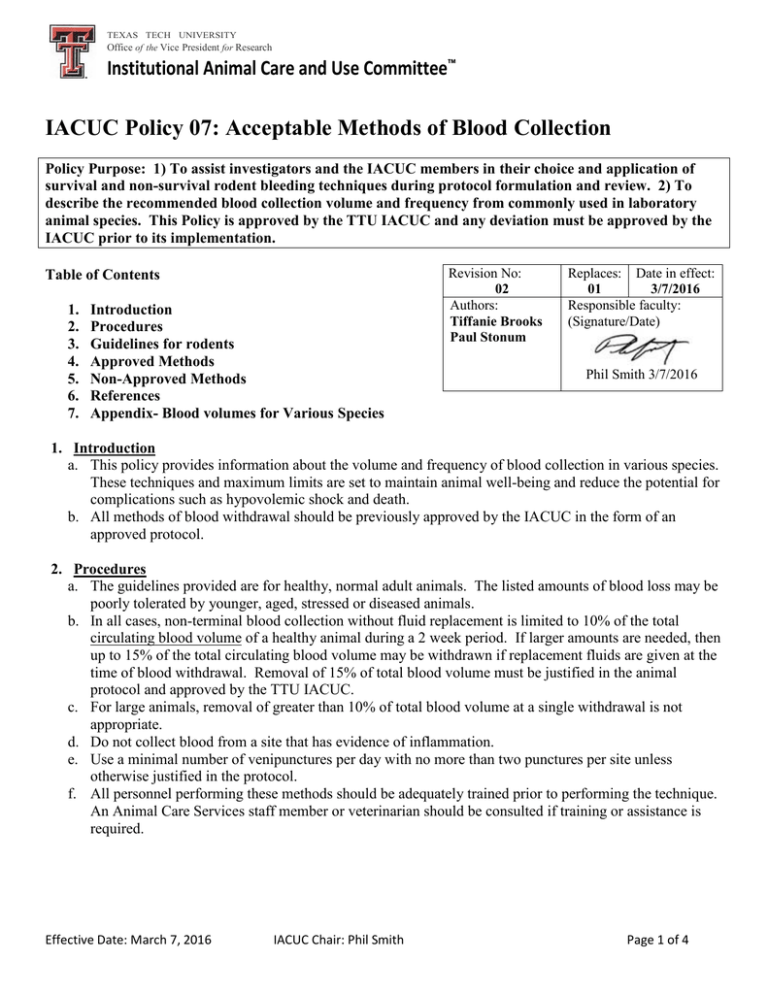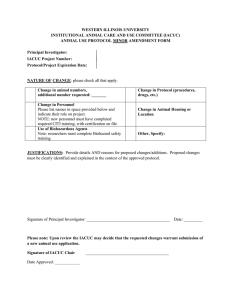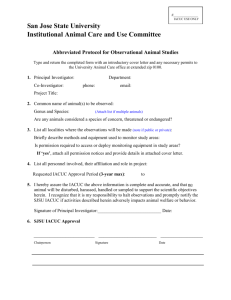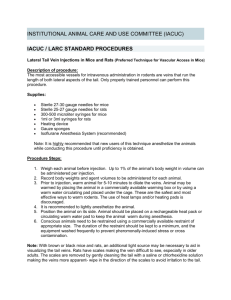IACUC Policy 07: Acceptable Methods of Blood Collection
advertisement

TEXAS TECH UNIVERSITY Office of the Vice President for Research Institutional Animal Care and Use Committee™ IACUC Policy 07: Acceptable Methods of Blood Collection Policy Purpose: 1) To assist investigators and the IACUC members in their choice and application of survival and non-survival rodent bleeding techniques during protocol formulation and review. 2) To describe the recommended blood collection volume and frequency from commonly used in laboratory animal species. This Policy is approved by the TTU IACUC and any deviation must be approved by the IACUC prior to its implementation. Table of Contents 1. 2. 3. 4. 5. 6. 7. Introduction Procedures Guidelines for rodents Approved Methods Non-Approved Methods References Appendix- Blood volumes for Various Species Revision No: 02 Authors: Tiffanie Brooks Paul Stonum Replaces: Date in effect: 01 3/7/2016 Responsible faculty: (Signature/Date) Phil Smith 3/7/2016 1. Introduction a. This policy provides information about the volume and frequency of blood collection in various species. These techniques and maximum limits are set to maintain animal well-being and reduce the potential for complications such as hypovolemic shock and death. b. All methods of blood withdrawal should be previously approved by the IACUC in the form of an approved protocol. 2. Procedures a. The guidelines provided are for healthy, normal adult animals. The listed amounts of blood loss may be poorly tolerated by younger, aged, stressed or diseased animals. b. In all cases, non-terminal blood collection without fluid replacement is limited to 10% of the total circulating blood volume of a healthy animal during a 2 week period. If larger amounts are needed, then up to 15% of the total circulating blood volume may be withdrawn if replacement fluids are given at the time of blood withdrawal. Removal of 15% of total blood volume must be justified in the animal protocol and approved by the TTU IACUC. c. For large animals, removal of greater than 10% of total blood volume at a single withdrawal is not appropriate. d. Do not collect blood from a site that has evidence of inflammation. e. Use a minimal number of venipunctures per day with no more than two punctures per site unless otherwise justified in the protocol. f. All personnel performing these methods should be adequately trained prior to performing the technique. An Animal Care Services staff member or veterinarian should be consulted if training or assistance is required. Effective Date: March 7, 2016 IACUC Chair: Phil Smith Page 1 of 4 TEXAS TECH UNIVERSITY Office of the Vice President for Research Institutional Animal Care and Use Committee™ 3. Guidelines for rodents Table 1: Approximate Blood Sample Volumes for a Range of Body Weights Body weight (g) *CBV(ml) 1% CBV (ml) 7.5% CBV (ml) 10% CBV (ml) every 7 days† every 2 wks† Circulating Blood Volume every 24 hrs† 20 1.10 – 1.40 .011 – .014 .082 – .105 .11 – .14 25 1.37 – 1.75 .014 – .018 .10 – .13 .14 – .18 30 1.65 – 2.10 .017 – .021 .12 – .16 .17 – .21 35 1.93 – 2.45 .019 – .025 .14 – .18 .19 – .25 40 2.20 – 2.80 .022 – .028 .16 – .21 .22 – .28 125 6.88 – 8.75 .069 – .088 .52 – .66 .69 – .88 150 8.25 – 10.50 .082 – .105 .62 – .79 .82 – 1.0 200 11.00 – 14.00 .11 – .14 .82 – 1.05 1.1 – 1.4 250 13.75 – 17.50 .14 – .18 1.0 – 1.3 1.4 – 1.8 300 16.50 – 21.00 .17 – .21 1.2 – 1.6 1.7 – 2.1 350 19.25 – 24.50 .19 – .25 1.4 – 1.8 1.9 – 2.5 *Circulating blood volume †maximum sample volume for that sampling frequency 4. Acceptable Methods Route Species Saphenous Vein Puncture Rats, Mice, Dogs, Cats Tail Vein Puncture Cardiac Puncture Cephalic Vein General Anesthesia Required No Extra training required No Rats, Mice, Cattle Rats, Mice No No Yes No Dogs, Cats, Pigs Mice No No No Yes Yes (rodents) No (others) No Yes (after weaning) No Facial Vein Puncture/Submandibular Jugular Vein Rats, Rabbits, Dogs, Cats, Farm Animals, Deer Tail Clip (Biopsy) Mice, Rats Effective Date: March 7, 2016 IACUC Chair: Phil Smith Comments Good for repeated small bleeds or one large bleed. Low potential for tissue damage. Use of a needle preferred resulting in less tissue damage to tail Non-Survival only; Animal must be deeply anesthetized and not recover from anesthesia Good for catheter placement Good for single large samples but some complications possible Limited application in rodents; Large samples in farm animals May be done one time at the same time as genotyping. Only soft tissue may be removed and not bone (2 mm of tail tip only) Page 2 of 4 TEXAS TECH UNIVERSITY Office of the Vice President for Research Institutional Animal Care and Use Committee™ Route Species Ear Vein Rabbits, Pigs General Anesthesia Required No Retro-orbital (Provisionally acceptable) Mice Yes Tail Snip Mice only No Extra training required Yes Yes Yes Comments Small, but repeated sampling; vein easily blown Adverse Effects • Eye infection, • Peri-orbital swelling, • Redness and/or hematoma formation, • Corneal ulceration, keratitis, pannus formation, rupture of the globe and micro-ophthalmia caused by proptosis of the globe, • Damage to the optic nerve, • Penetration of the eye globe, and • Blindness Cautionary statements • Retro-orbital sampling has a greater potential than other blood collection routes to result in complications • A minimum of 10 days should be allowed for tissue repair (USDA Category D) Good for small, multiple samples over a short period of time, by removing the clot/scab after the initial cut. Cut should be made < 1 mm from the tip of the tail, or can cause permanent damage. 5. Non-Acceptable Methods Route Penile or Lingual Vein Amputation of a body part: tail or toe (exception is single use of tail; see above) Cardiac puncture as a survival procedure Effective Date: March 7, 2016 Reasons for non-approval Potential for thrombosis leading to blockage of the urethra or swelling of the tongue Can lead to granuloma formation resulting in a mass a the end of the tail leading to pain; repeated amputation results in cutting of bone and samples that are hemolyzed and contaminated with other tissue. Damage to lungs and/or heart, potential to lacerate major vessel resulting in death, bleeding into the pericardium resulting in cardiac arrest IACUC Chair: Phil Smith Page 3 of 4 TEXAS TECH UNIVERSITY Office of the Vice President for Research Institutional Animal Care and Use Committee™ 6. Appendix- Blood Volumes for Various Species. Adapted from Wolfensohn & Lloyd, 2003, Handbook of Laboratory Animal Management and Welfare, 3rd Edition Reference Weight (g) Blood volume (ml/kg)a Mouse 18-40 58.5 Rat 250-500 54-70 Ferret Rabbit Chicken Quail Dog Cat Pig Sheep Goat Horse Cattle Deer 750-1500 1000-6000 1000-3000 110-200 75 57-65 60 65-100 70-110b 47-65 56-69 58-64 57-90 75 60 66a Species 45,000-125,000 Circulating Blood Volume (CBV), normal adult (ml); 10% CBV q 2-4 weeks Male 1.5-2.4 ; (0.15-0.24 ml) Female 1.0-2.4; (0.1-0.24 ml) Male 29-33; (2.9-3.3 ml) Female 16-19; (1.6-1.9 ml) 50-110; (5-11 ml) 160-480; (16-48 ml) 60-180; (6-18 ml) 7.56-20; (0.75-2ml) 900-1170c; (90-117 ml) 140-200; (14-20 ml) 13,200-15,000 (1.3-1.5 L) 4060-4480; (406-448 ml) 3990-6300; (390-630 ml) 33,750-45,000d; (3.3-4.5 L) 27,000-36,000d; (2.7-3.6 L) 2970-8250; (297-825 ml) aBlood volume estimate for a single species may not reflect differences among individual breeds or variations due to age, size or illness bMuch breed variation cBeagle dAssumes adult weight 450-600 kg 7. References nd • Wolfensohn, S., Lloyd, M. 2 Edition, Blackwell Science Ltd. 1998. • Guidelines for survival bleeding of mice and rats; http://oacu.od.nih.gov/ARAC/documents/Rodent_Bleeding.pdf http://www.ncbi.nlm.nih.gov/pmc/articles/PMC3189672/pdf/jaalas2011000680. • Cornell University IACUC ACUP 403 Recommended Blood Collection Volume and Frequency. http://www.research.cornell.edu/care/documents/ACUPs/ACUP403.pdf Effective Date: March 7, 2016 IACUC Chair: Phil Smith Page 4 of 4






